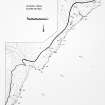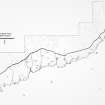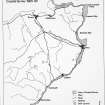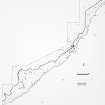Latheronwheel
Chambered Cairn (Neolithic)
Site Name Latheronwheel
Classification Chambered Cairn (Neolithic)
Alternative Name(s) Knockinnon, Lat 276
Canmore ID 8147
Site Number ND13SE 3
NGR ND 1844 3168
Datum OSGB36 - NGR
Permalink http://canmore.org.uk/site/8147
- Council Highland
- Parish Latheron
- Former Region Highland
- Former District Caithness
- Former County Caithness
ND13SE 3 1844 3168
(ND 1844 3168) Chambered Cairn (NR)
OS 1:10,000 map, (1979)
An extremely ruined cairn now reduced to an indefinite grass-grown mound. A large upright stone facing E-W stands 4ft 8ins high, 2ft 6ins wide and 1ft 3ins thick about the centre of the cairn. To the E of it, a long parallel slab, and to the S a smaller parallel slab, show through the turf; these might be the end-stone and the divisional stone of a chamber.
A S Henshall 1963.
A robbed chambered cairn, 18.0m in diameter and 0.8m high. Four slabs of the chamber remain.
Surveyed at 1:2500.
Visited by OS (N K B) 14 March 1968.
West of the large upright at a distance of 1.2m is a parallel slab showing to 0.4m long and 0.4m high. This appears to be another divisional slab of a chamber. The chambered cairn is otherwise as described above.
Visited by OS (JM) 13 October 1982.
The cairn is at about 60m OD near the edge of a terrace which is now pasture but was formerly cultivated. The ground drops gently from NW to SE, and a short distance SE of the cairn it drops abruptly in outcrop to a lower terrace and the sea 170m away.
A rim of turf-covered cairn material remains, 1.3m high at its maximum on the S side. The approximate edge of the cairn can be traced on the NE and SW, but is indistinct on the SE, and on the NW which faces the former field the cairn has been robbed to almost ground level as far as the paired orthostats. The cairn diameter has been roughly 19m.
Near the centre of the cairn is a pair of low slabs set 0.6m apart, facing SE and NW. They are almost the same height and retain their original upper edges. The NE slab is exposed for 0.3m, but the other is barely showing. The slabs are 0.75 and 0.5m long and 0.2m thick. An imposing slab stands 0.85m to the NW. It is 1m higher than the paired slabs and is exposed for 1.45m which is almost its full height; its upper surface is intact and slopes down to the NE. The slab is 0.75m long and 0.4m thick. Its partner is almost certainly represented by a group of shattered slabs lying in a hollow on its SW side. A metre to the NW the stump of a fourth slab projects 0.4m; it is 0.5m long and 0.2m thick.
These slabs could be interpreted as the portal stones at the inner end of a passage running from the SE, one of a pair of tall inner portal stones between the ante-chamber and chamber, and one of a pair of slabs subdividing the main chamber the back of which has been destroyed.
J L Davidson and A S Henshall 1991, visited 5 September 1986.
Project (1980 - 1982)






















